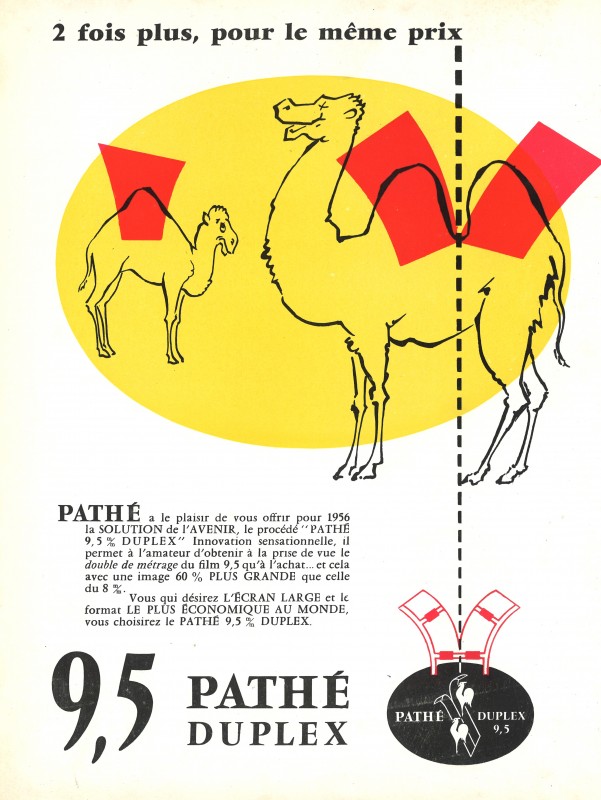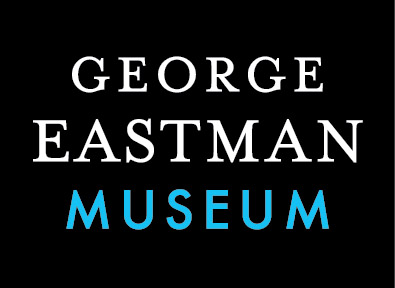Pathé Duplex-Monoplex(1954–c.1968)
A dual format that used special double-perforated 9.5mm film. Home movies could be shot vertically in the standard 9.5mm format, or horizontally along both sides of the film; after processing the film was slit in half to create a film strip 4.75mm-wide for horizontal projection in widescreen.
Film Explorer

4.75mm Monoplex home movie, photographed on Kodachrome reversal film by Ralph Laclôtre, c.1957.
Fonds Ralph Laclôtre, Fondation Jérôme Seydoux-Pathé, Paris, France.

Frames from a B/W 9.5mm Duplex film, shot in panoramic format. One side of the film was exposed first, then the spool of film was turned over and the other side exposed in the reverse direction. After processing, the laboratory slit the film down the middle and spliced it end-to-end, giving a reel twice the original length. Unidentified home movie, c. 1956.
Private collection.

9.5mm Duplex film, photographed vertically with a standard 9.5mm camera aperture. Unidentified home movie, 1959. Note the double perforations.
Fonds Jean Bonnet, Fondation Jérôme Seydoux-Pathé, Paris, France.
Identification
Monoplex: 6mm x 3.55mm (0.236 in x 0.139 in); Duplex: 8.2mm x 6.2mm (0.323 in x 0.244 in).
1.69:1 (Monoplex); 1.3:1 (Duplex).
1
9.5mm Duplex film was available in both B/W and Kodachrome reversal.
None
The Lido Duplex camera used special double-perforated 9.5mm Duplex film. Normal images could be photographed vertically like standard 9.5mm film, or widescreen images could be captured horizontally on each side of the film. In widescreen mode, the 9.5mm Duplex film was slit into 4.75mm Monoplex film after processing for horizontal projection.
Monoplex: 6.5mm x 4.25mm (0.255 in x 0.167 in); Duplex: 8.5mm x 6.5mm (0.335 in x 0.256 in).
9.5mm Duplex: Two rectangular perforations positioned on the divide between each frame. 4.75mm Monoplex: Single perforation between each frame.
Pathé B/W reversal; Kodachrome.
Standard 9.5mm reversal edge markings – often hard to see.
History
Pathé invented the amateur 9.5mm format in 1922, and it remained popular throughout Europe until after the Second World War. However, during the 1950s, the 9.5mm format declined in popularity. It was no longer considered the most cost-effective format for non-professionals. The amateur film market favored 8mm, which benefited from the huge popularity of 8mm Kodachrome, as well as the fact that 9.5mm stock was twice the price of 8mm. To preserve its flagship format and remain competitive, Pathé capitalized on the popularity of the new widescreen formats in commercial cinemas to modernize and extend the uses of 9.5mm.
Research for a new format began in November 1954. Without discarding the technical characteristics that had defined the 9.5 format – its width, frame pulldown, or central-perforation principle – the engineers began to think about a new perforation system that would enable them to change the image ratio while keeping the same width of film. The single central hole was replaced by a pair of perforations close to the central axis. With this new double-perforated film, known as Duplex, it was possible to shoot in two different framings: vertically, in the standard 9.5 format; or horizontally, in a panoramic format occupying half of each frame. In panoramic mode, after processing the Duplex film was slit in half lengthwise to become a Monoplex film, 4.75mm-wide, with a single, central perforation. This doubled the Monoplex projection time compared with Duplex. Double format, double length – the system offered mulitple economic advantages.
Although the horizontal Monoplex format did not increase the size and resolution of the projected image – as was the case with theatrical widescreen formats like CinemaScope and VistaVision – it did offer amateur film enthusiasts the opportunity to make films with a panoramic aspect ratio, which was, at this time, becoming the new aesthetic standard for cinematographic art. Similar initiatives followed from industry competitors, with other manufacturers offering “wide” formats based on 16mm and 8mm – such as the 16/8 Panoramique camera from Dimaphot and Emel’s Panascope (Pan-8) in France – but Monoplex was the first amateur widescreen format brought to market. The image area of Monoplex was 60 per cent larger than that of a standard 8mm frame. Pathé’s claim that the 9.5 Duplex was “the cheapest [widescreen] film in the world” was arguably true. The Monoplex widescreen mode was an inventive way of “modernizing” 9.5mm, presenting a more attractive and cost-effective offering to the consumer.
Société Commerciale et Industrielle Pathé (SCIP) signed an agreement with Kodak-Pathé to produce 9.5mm Duplex perforated film and develop the industrial tools required for its manufacture: special perforating machines and slitters. To support Duplex’s launch and hopefully ensure its commercial success, SCIP hired Bureau Technès, a leading industrial design consultancy headed by Roger Tallon, to design the new, state-of-the-art equipment.
The resulting Lido camera, and accompanying Monaco projector, were praised for their innovative design and served as a showcase for the new format. SCIP premiered 9.5mm Duplex film at the inaugural Biennale de Photo-Cinéma, held at the Grand Palais, Paris, in May 1955. Commercial distribution didn’t fully begin until spring 1956, mainly in France and neighbouring European countries, but also in Australia and New Zealand. The invention of the Duplex-Monoplex format was acclaimed by the trade press and raised the hopes of customers loyal to the 9.5mm. However, it was not as successful as hoped. The narrowness of 4.75mm Monoplex film made it difficult to handle, the increasingly competitive amateur film market and the ascendancy of 8mm made the decline of 9.5mm inevitable. Although manufacture of the Lido camera and Monaco projector was discontinued in 1962, Kodak-Pathé continued to manufacture double-perforated Duplex film until about 1968.
Technology
Pathé Duplex provided for two potential formats on the same film: the double central perforations allowed the photographer to choose the framing. With the Lido Duplex camera, images could be captured in the “classic” 9.5mm format, taking up the entire width of the strip, running the film vertically, alternatively, by rotating the camera through 90 degrees, images could be captured horizontally on half the strip in a panoramic frame ratio, in the manner of Vistavision. A sliding switch would decrease the size of the camera aperture plate, so that only one half of the film was exposed. In this use case, the reel was flipped over at the end of its first pass through the camera, in order to record images on the second half of the film strip, in a reverse direction – in the same manner as for Standard 8mm. Exposed films were sent to the laboratory, the film was processed and then slit in half longitudinally. Thus, 15m (49.2 ft) of 9.5mm Duplex equated to 30 m (98.4 ft) of 4.75mm Monoplex, which was then projected horizontally, using the Monaco projector. Pathé’s advertising argument was that for the purchase price of a 15m reel of Duplex 9.5mm, the resulting projection time was double that of classic 9.5mm.
The Lido camera and Monaco projector could switch from one format to the other, giving amateur filmmakers freedom of choice. There was no need for additional accessories or tools – format changes were made by a simple rotation of the lens head. In addition, the Monaco projector could also handle classic 9.5mm film with its single, central perforation. The versatility of these devices ensured continuity between classic 9.5mm and the new 9.5mm Duplex. It’s worth noting that SCIP offered, on request, a conversion service for older equipment, such as the Marignan projector and the National II camera, to make them compatible with the Duplex-Monoplex format.
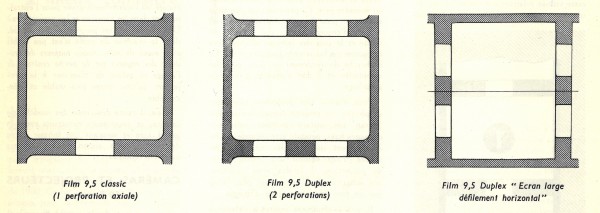
“Classic” 9.5mm film compared against the Duplex and Monoplex formats.
Le Cinéma chez soi, 1 (May–June), 1955: pp. 42–5.
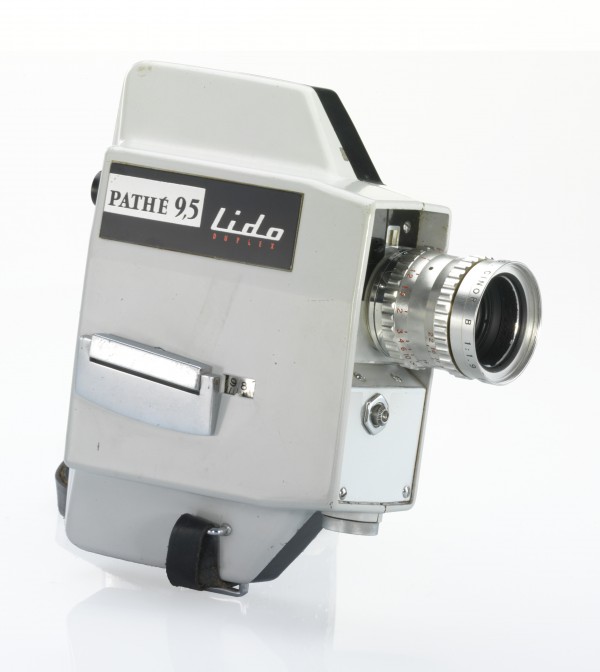
Pathé Lido 9.5 Duplex camera, 1956.
Fonds Robert Guénet, Fondation Jérôme Seydoux-Pathé, Paris, France. Photography by François Ayme.
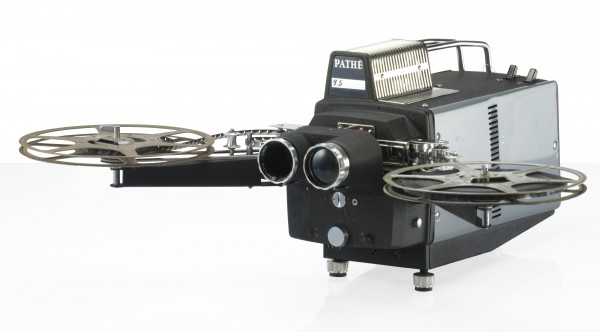
Pathé Monaco 9.5mm Duplex projector, in horizontal screening mode for the Monoplex format, 1956.
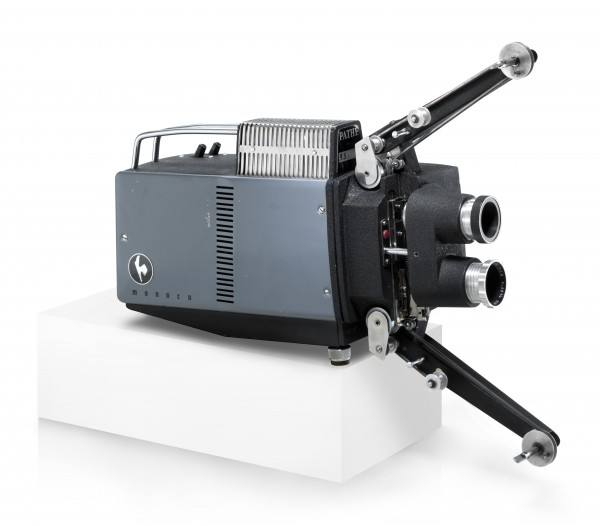
Pathé Monaco 9.5mm Duplex projector, in vertical screening mode for the 9.5mm Duplex, or classic 9.5mm, format, 1956.
Fonds Jean-Claude Laubie, Fondation Jérôme Seydoux-Pathé, Paris, France. Photography by François Ayme.
References
Edmonds, Guy (2007). “Amateur widescreen; or, some forgotten skirmishes in the battle of the gauges”. Film History, 19: pp. 401–413.
Hémardinquer, Pierre (1955). “Le 9,5 mm, un format méconnu qu’on gagnerait à mieux connaître”. Le cinéma chez soi, 1 (May–June): pp. 42–45.
Mazard, Jean (1956). “Les trois grands… et les trois petits”. Ciné amateur, 202, (April): p. 11.
Pagéty, André (1955). “Ecran large et cinéma d’amateurs. Suivi de quelques-unes des ‘nouveautés’ de la Biennale et le PATHE DUPLEX 9,5”. Ciné amateur, 190 (April): pp. 7–14.
Société Nouvelle Pathé-Cinema (1955). “La triple “bombe” du ciné-amateur: l’ensemble Duplex-Lido-Monaco”. Le Cinéma chez soi, 4, (December): pp. 32–35.
Société Nouvelle Pathé-Cinema (1956). “Le film le plus économique du monde”, Le Cinéma chez soi, 6, (May): pp. 34–36.
Steve the 95collector (2022). “4.75mm Film – Ultra Rare Colour Monoplex Home Movie from the late 1950s (accessed June 17, 2024). https://www.youtube.com/watch?v=kt2z4WrwlkU
Patents
Société Nouvelle Pathé-Cinéma. Procédé pour la réalisation de films cinématographiques et films conformes à ceux utilisés obtenus, French Patent FR1121403, filed March 28, 1955, and issued August 14, 1956. https://data.inpi.fr/brevets/FR1121403?q=1121403#FR1121403
Société Nouvelle Pathé-Cinéma. Appareil pour la projection de films cinématographiques, French Patent FR1135267, filed May 5, 1955, and issued April 26, 1957. https://data.inpi.fr/brevets/FR1135267?q=1135267#FR1135267
Preceded by
Compare
Related entries
Author
After studying history, Anne Gourdet-Marès worked as a projectionist and camera assistant. With a passion for the history of cinematographic techniques, she is in charge of the cinematographic equipment collection at the Jérôme Seydoux-Pathé Foundation. Her research on the history of cameras, and their support, has been the subject of several papers and publications. As a court-appointed expert in her field, she is often consulted on technical issues. She also creates magic lantern shows and educational workshops exploring the technical inventions of cinema. In 2018, she published Si on allait au cinéma! for young audiences, published by À dos d'âne. To mark the centenary of Pathé-Baby, she curated the exhibition “Pathé-Baby: le cinéma chez soi”, held at the Fondation Jérôme Seydoux-Pathé in 2022.
Gourdet-Marès, Anne (2024). “Pathé Duplex-Monoplex”. In James Layton (ed.), Film Atlas. www.filmatlas.com. Brussels: International Federation of Film Archives / Rochester, NY: George Eastman Museum.
